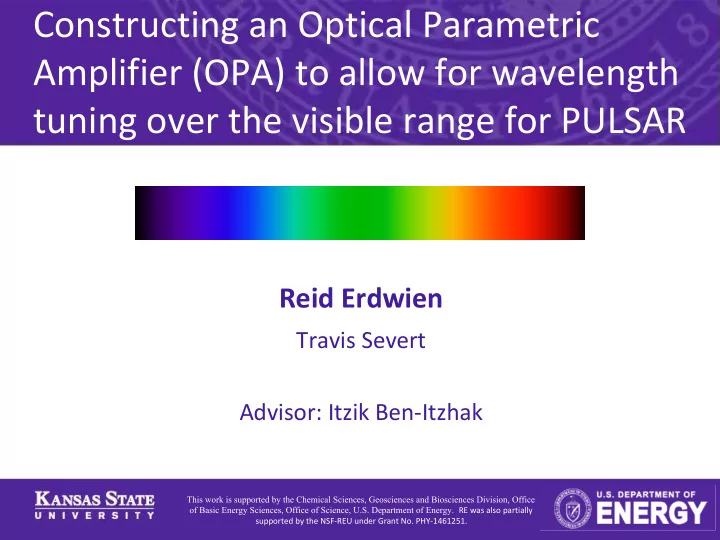

Constructing an Optical Parametric Amplifier (OPA) to allow for wavelength tuning over the visible range for PULSAR Reid Erdwien Travis Severt Advisor: Itzik Ben-Itzhak This work is supported by the Chemical Sciences, Geosciences and Biosciences Division, Office of Basic Energy Sciences, Office of Science, U.S. Department of Energy. RE was also partially supported by the NSF-REU under Grant No. PHY-1461251.
What is an OPA? Arrangement of optical elements which, using Nonlinear Optics , allows for a pump laser to amplify a range of wavelengths thus creating a laser source of tunable wavelength The goal for our specific OPA is for the tunability to be roughly over the visible spectrum (390-700nm)
Why do we want an OPA? D.T. Chang et al ., The Journal of Chemical Physics 117, 5757 (2002)
Nonlinear Optics
Nonlinear Processes Second Harmonic Generation Difference Frequency Generation Virtual State Virtual State Ground State
OPA process Positive feedback loop leads to efficient amplification C Manzoni and G Cerullo 2016 J. Opt. 18 103501
Phase Matching
Non-Collinear Phase Matching Signal and Pump crossing Broadband phase-matching can be non-collinearly achieved with specific crossing angle Signal Pump OPA crystal C Manzoni and G Cerullo 2016 J. Opt. 18 103501
From Theory to Design Known Technology: We can look to what others have done Make major design decisions Once we have an overarching design we can start ordering the optical elements that we will need This was a long process with many minor design decisions D. Brida et al ., J. Opt. 12(1), 013001 (2010).
Our Setup Telescope (x4) 99% BS SHG BBO Delay line White light generation OPA Crystal Filter Focusing optics
Results Video as SHG delay is varied Output spectra with various delays
Known Problems 1 Spatial Chirp – can be seen in the beam on our table and in the PULSAR room 2 Focusing Optics – Missed ordering a mount. This affects the quality of our signal beam 3 Various other changes in the exact optics arrangement
Future endeavors • Optimize first stage of the OPA • Build the second stage of the OPA for output stability • Compression the output pulse in time • Miniaturize the OPA as much as possible
Thank you! Itzik Ben-Itzhak group Laser Assistance Itzik Ben-Itzhak Charles Fehrenbach Kevin Carnes Raju Pandiri Travis Severt Bethany Jochim Peyman Feizollah Shitong Zhao And, of course, the entire K-State Physics REU program!
C Manzoni and G Cerullo 2016 J. Opt. 18 103501
C Manzoni and G Cerullo 2016 J. Opt. 18 103501
C Manzoni and G Cerullo 2016 J. Opt. 18 103501
Recommend
More recommend